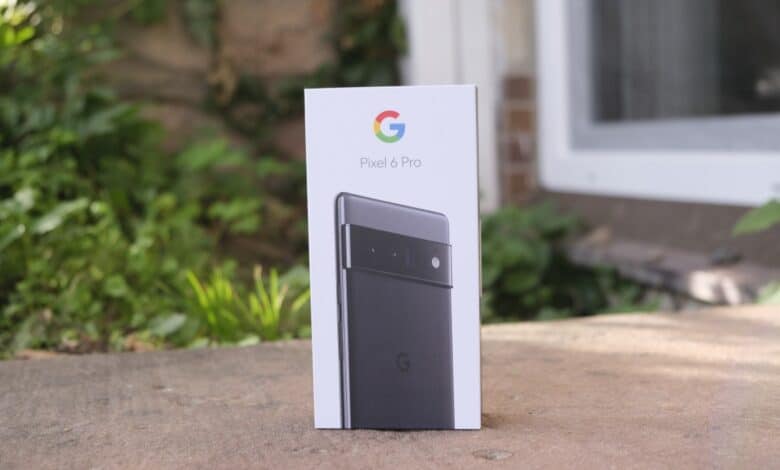
The long wait is finally over. The Google Pixel 6 Pro and its smaller brother Pixel 6 have been available in stores for a few days now. After the predecessor, the company finally wants to deliver a flagship smartphone that is supposed to convince in all areas. Our Google Pixel 6 Pro review clarifies how well that was achieved.
Technical Specifications
| Operating system | Android 12 |
| Display | 6.71″, 1440 x 3120 pixels, AMOLED, 120 Hz, 512 PPI |
| SoC | Google Tensor |
| CPU | 2 x 2.80 GHz Cortex-X1 2 x 2.25 GHz Cortex-A76 4 x 1.80 GHz Cortex-A55 |
| GPU | Mali-G78 MP20 |
| RAM | 12 GB |
| Memory | 128 GB (test device) / 256 GB |
| Battery | 5,003 mAh, permanently installed, 30 watts wired charging |
| Dimensions | 163.9 x 75.9 x 8.9 mm |
| Weight | 210 g |
| Interfaces | USB Type-C 3.1, Wi-Fi 802.11 a/b/g/n/ac/6e, Bluetooth 5.2, NFC, GPS |
| Inserts | 1x Nano SIM (5G) |
| Camera (rear) | 50MP wide-angle camera (f/1.85, laser autofocus sensor, OIS, 82-degree field of view) 12-MP ultra-wide-angle camera (f/2.2, 106.5-degree field of view) 48 Megapixel telephoto zoom camera (f/3.5, 23.5 degree field of view, 4x optical zoom) |
| Camera (front) | 11.1 megapixels (f/2.2 aperture, 94° ultra-wide field of view, fixed focus) |
| Available colors | Stormy Black (test unit), Cloudy White, Sorta Sunny |
| Price | € 19.57 * (128 GB storage); 999.00 euros (256 GB storage) |
Scope of delivery
The Google Pixel 6 Pro comes in a minimalistic, white box, which is hardly bigger than the smartphone itself. Accordingly, the scope of delivery also turns out to be manageable. When we open the box, we immediately see the smartphone, in our case in the black variant – called “Stormy Black”.
Google also includes a long USB-C to USB-C charging cable and an adapter for transferring data from another smartphone (and even from the iPhone). The usual manuals and safety instructions round off the scope of delivery. A power adapter is unfortunately not in the box, for environmental reasons, as they say. Too bad.
Design and build quality of the Pixel 6 Pro
The Google Pixel 6 Pro stands out, that much is clear at first glance. In terms of design, the Pixel 6 is very different from its predecessors, but no less different from any other smartphone on the market – though whether you like that is up to each individual to decide.
The first thing that stands out is that the Google Pixel 6 Pro is quite large. With dimensions of 163.9 x 75.9 x 8.9 mm, the 6.71-inch smartphone is gigantic. It is slightly shorter in length than Samsung’s Galaxy S21 Ultra (165.1 mm), for example, but slightly wider (75.6 mm). Compared with the iPhone 13 Pro Max (160.8 x 78.1 x 7.7 mm), the smaller width is especially noticeable and provides a pleasant grip.
But back to the design of the Pixel 6 Pro. The front is almost completely taken up by the AMOLED screen, which also has curved edges compared to the smaller Pixel 6 and thus extends a bit beyond the edges. The display’s edges are pleasantly narrow. Google has installed the front-facing camera in a punch-hole in the center of the screen’s upper edge.
The sim card slot is on the left and only has room for a nano-Sim. Thus, an SD card or a second SIM card cannot be used. However, the Pixel 6 Pro has dual-SIM functionality that is achieved via an internally installed eSIM.
The controls in the form of the power button and the volume rocker are both located on the right side of the device. They are placed in the upper third and are easily accessible even in one-handed operation.
Similar to the original Pixel and Pixel 2, the back is divided into two colors. The lower part is clearly darker, and the wide camera strip serves as a separation from the somewhat lighter upper part. Overall, the design of the Pixel 6 Pro looks sophisticated and elegant. The cameras also do not stick out as far as I had previously thought. Due to the even arrangement across the entire width, the smartphone also sits on the table without wobbling.
Workmanship and feel
Overall, I like the workmanship of the Google Pixel 6 Pro exceptionally well. The device looks like it was made of one piece, there are no gaps or irregularities. In fact, you have the feeling that you are holding a real flagship device in your hands.
I also find that the Pixel 6 Pro is really comfortable to hold. It has a good width, so even I can use the device safely with small hands – and that with only one hand. Compared with the OnePlus 9 Pro, the significantly higher weight (210 grams versus 197 grams) is noticeable. However, this is not negative when you consider that the S21 Ultra, for example, weighs about 20 grams more.
All in all, I am pleasantly surprised by the build quality and feel of the Pixel 6 Pro. Despite the sheer size, Google has managed to create a smartphone that is comfortable to hold. Not least thanks to Gorilla Glass Victus and an aluminum frame, the device looks extremely high-quality.
Display of the Pixel 6 Pro
Google relies on a color and high-contrast AMOLED panel with a QHD+ resolution (1440 x 3120 pixels), 120 Hz refresh rate (adaptive) and a pixel density of 512 ppi for the Pixel 6 Pro. In practice, the display offers a razor-sharp picture with an outstanding color reproduction that only has to admit defeat to the displays of the iPhone 13 Pro models in our eyes.
Especially the white value and the maximum brightness (800 nits in automatic mode) are simply outstanding for an OLED display. The screen is always easy to read even in strong sunlight. The smartphone automatically adjusts the adaptive refresh rate between 10 and 120 Hz depending on the currently displayed content. For texts or in social networks, this enables pleasantly smooth scrolling, while battery life is saved when displaying pictures or static content.

However, the display is also the first big point of criticism for the Google Pixel 6 Pro, and that is the fingerprint sensor. The device relies on an optical in-display sensor that is convincing in terms of position and size, but it works a bit slowly and recognizes our finger much less precisely than Samsung or OnePlus, for example. It is not uncommon that the Pixel only accepts our finger for unlocking after the third attempt. That is annoying from time to time.
Hardware: What does the Tensor SoC do in the Pixel 6 Pro?
Perhaps the most exciting innovation of the 6th Pixel generation can be found in the Tensor Chip, because similar to Apple, Google now relies on an in-house developed SoC and does not fall back on models from suppliers.
Thanks to artificial intelligence (AI) and machine learning (ML) directly on the device, they thus want to offer the smartest and most secure Android smartphone on the market. And the Google Pixedl 6 Pro actually delivers that in many areas. However, it is by no means the fastest smartphone, as our benchmark tests will show – nevertheless, to anticipate that, the speed is on flagship level.
Indeed, Google has managed to deliver an impressive performance with the symbiosis of pure Android and Tensor chip. The Pixel 6 Pro boots faster than any other Android device when turned off. The smartphone is fully booted in about 9 seconds, all apps are loaded in the background, and a post on Facebook or Twitter can be sent in another 6 seconds, for example.
Opening or switching between apps works in fractions of a second and scrolling with the 120 Hz display is simply a pleasure. Jerks or lags did not occur at any point during our test.
Tensor lags behind Snapdragon
The Pixel 6 Pro does not make any noteworthy mistakes in terms of everyday performance or in current games. However, the octa-core CPU in the Tensor SoC does not quite reach the rates of a current Snapdragon in the purely synthetic benchmarks.
In Geekbench 5, the Pixel 6 Pro is minimally beaten by the Galaxy S21 Ultra or OnePlus 9 Pro in terms of single-core performance, but it is clearly beaten by the Apple iPhone 13 Pro Max. The Google smartphone is also behind in the multi-core score.
However, it looks much better in the 3DMark Wild Life graphics benchmark, where the Pixel 6 Pro scores more points than the Samsung or OnePlus rivals – but the current iPhone is clearly ahead here as well. In the AnTuTu benchmark, however, the Pixel 6 Pro is again beaten by the competition.
| Benchmark results of the Pixel 6 Pro | |
| Geekbench 5 single-core: | 1037 |
| Geekbench 5 Multi-Core: | 2876 |
| 3DMark Wild Life: | 6615 |
| 3DMark Wild Life Extreme: | 1921 |
| AnTuTu (V 9.1.8.): | 719897 |
In summary, the Tensor chip in the Google Pixel 6 Pro cannot quite keep up with current Snapdragon SoCs or the Apple A15 Bionic in terms of performance. However, you will only notice little of that in everyday use.
The pure system performance, but also the gaming performance is completely convincing and I especially like the fast and smooth handling. Especially since there are absolutely no jerks or hangs compared to the S21 Ultra or OnePlus 9 Pro is very pleasant.
Software: Android 12
Of course, the Pixel 6 Pro uses stock Android, which is already in version 12 ex-works. Android 12 including the new Material You design is the biggest design change the operating system has seen in years. The design is primarily characterized by its customizability. Be it through unique, customizable widgets or a general color scheme based on the selected background image.
In general, the system performance of the pure Android is, unsurprisingly, excellent. There is no bloatware, only the well-known Google apps are preinstalled on the device. As is typical for Google, all Android updates are available first. In addition, the Pixel 6 generation will receive security updates for five years as well as Android updates for three years and is thus well prepared for the future.
Personally, I really like Android 12 including Material You, although as a long-time Android user you have to get used to it a bit due to the redesigned user interface.
Pixel 6 Pro camera: The new camera king?
Google’s Pixel smartphones have always been known for their outstanding camera, accordingly my expectations for the Pixel 6 Pro were also enormous. In the practical test, these expectations were met in many respects and sometimes even exceeded. However, the cameras of the Pixel 6 Pro are still not perfect.
Note: All pictures are unedited original shots directly from the Google Pixel 6 Pro.
The camera UI
Google convinces with a clear, uncluttered camera user interface. Below the displayed image, the different zoom levels (0.7x for ultra-wide, 1x, 2x and 4x optical zoom) are available for selection.
At the bottom of the screen you can choose between different shooting modes like night vision, motion, portrait or panorama or switch to video recording mode. At the top left, you open the options menu, where you can select further fine-tuning settings like flash, top photo, timer or aspect ratio. Everything is simple and easy to understand.
If you focus manually by touching the screen, sliders open up that allow you to manually adjust the white balance, exposure and contrast.
The Pixel 6 Pro’s front-facing camera
On the front, Google installs an 11.1-megapixel selfie camera complete with f/2.2 aperture. It actually marks the weakest link in the chain of the camera setup in the Google Pixel 6 Pro, but still delivers convincing results.
Only the colors of the face and the sharpness give some cause for criticism. While the results of the front-facing camera are good in good lighting conditions, the camera quickly reaches its limits in low or difficult lighting conditions and cannot quite keep up with the competition. However, I particularly liked the portrait mode, which reproduces the subject in focus very sharply and convinces with a pleasant bokeh.
The triple camera of the Pixel 6 Pro
On the back, Google installs a triple camera setup in the case of the Pixel 6 Pro, which is made up of the following lenses:
- 50-MP wide-angle camera (f/1.85, laser autofocus sensor, OIS, 82-degree field of view)
- 12-MP ultra-wide-angle camera (f/2.2, 106.5-degree field of view)
- 48-megapixel telephoto zoom camera (f/3.5, 23.5-degree field of view, 4x optical zoom, 20x super res zoom)
All three cameras are then completely convincing and offer accurate color reproduction with an incredible sharpness and an enormously high level of detail. Especially the main camera, but also the zoom lens position themselves at the spearhead of current smartphones, only the ultra-wide-angle camera falls a bit in comparison.
The sheer picture quality is already convincing. In combination with the AI-based post-processing of the Tensor chip, the Pixel 6 Pro gets even more out of the pictures without losing the natural characteristics of the recorded scene.
Excellent zoom
However, the telezoom camera is also impressive, delivering a razor-sharp image even with the maximum possible optical zoom (4x magnification). In combination with the digital Super Res Zoom (20x magnification), you get an incredibly versatile camera whose results are still impressive.
In direct comparison with the 10x zoom of the Galaxy S21 Ultra, the Pixel 6 Pro does not have to hide at all and offers a similarly good result with the same magnification. This once again shows Google’s excellent software processing.
The image stabilization is no less impressive. Even hands-free shooting at full 20x zoom is possible without blur and still produces crisp, sharp pictures.
Night shots with the Pixel 6 Pro
What is noticeable, however, is that the Pixel 6 Pro takes significantly more time in exposing night shots than, for example, an iPhone 13. While the Apple device shoots even dark scenes in 3, maximum 4 seconds, the Pixel takes up to 13 seconds. This captures even more details and achieves an even higher brightness, but the smartphone is also more susceptible to camera shake in the process – which makes the use of a tripod almost necessary.

The quality of the night shots is simply outstanding. The Pixel 6 Pro even achieves this automatically in some cases, without even having to switch to night vision mode for it. The result is more than respectable, especially since the scene recorded with it then looks a bit more natural.
Smart Features: Magic Eraser and Text Recognition
An exciting, but in practice double-edged sword, are the new smart features of the camera, which are also achieved by the Tensor chip. For example, there is the magic eraser, which can remove unwanted people or objects from pictures.
This sometimes works well and sometimes less satisfactorily. Especially the manual removal of unwanted elements does not always work reliably.
I like the text recognition much better: Thanks to Google Lens, the Pixel 6 Pro reliably recognizes text on photos and lets you copy it out completely if desired – extremely practical.

Battery, charging time and speaker
Google equips the Pixel 6 Pro with a 5,000 mAh battery and thus offers, purely nominally, significantly more capacity than OnePlus, for example, and the same size as Samsung in the case of the S21 Ultra.
Thanks to the redesigned battery usage display in Android 12, it is a bit difficult to draw exact conclusions. This is because only the battery usage in the last 24 hours can be displayed here anymore, but not since the last charging process.
While the Pixel 5 was an absolute battery king, the Pixel 6 Pro is only average among Android flagships. Although the battery of the new Google flagship still easily lasts over a day, it has to admit defeat to Samsung and Apple.
The Pixel 6 Pro lasted for about 13 hours during continuous web browsing with an enabled 120 Hz display. That is just under an hour less than the Samsung Galaxy S21 Ultra and about five hours less than the iPhone 13 Pro Max. On the other hand, it is also about one and a half hours more than in the case of the OnePlus 9 Pro.
Charging also takes quite a bit of time by today’s standards thanks to the maximum possible speed of 23 watts (although Google even includes a 30-watt power supply). Fully charging the empty battery to 100 percent takes around one and a half hours – especially when you are used to the advantages of a OnePlus or Xiaomi smartphone, which need just 17 minutes for this in the best case (Xiaomi 11T Pro), this is no longer quite up to date.
Last but not least, we want to mention the built-in stereo speakers of the Google Pixel 6 Pro, which achieve an incredibly high volume without distorting. Thus, the smartphone also cuts a good figure as a wireless speaker.
Conclusion on the Google Pixel 6 Pro
I’ll admit it openly: I have always been a big fan of the Pixel smartphones. The combination of pure Android operating system and excellent cameras makes the Google devices the most interesting smartphones the operating system has to offer for me.
The Pixel 6 Pro also puts its exclamation points exactly in these areas. Google has once again managed to deliver one of the best, if not the best camera setups on the market, although the selfie cam falls a bit short here.
Especially compared to the in-house predecessor, the Pixel 6 represents an incredible leap in all aspects. The design and build quality are beyond reproach, and the AI and machine learning capabilities of the new Tensor chip open up a wide range of new and exciting possibilities, which will, however, only become fully apparent in the coming months.

The fact that the sheer hardware power cannot quite keep up with Apple or other Android flagships can be gotten over in my eyes. However, users who value the best possible gaming performance will probably not be happy with the Pixel 6 Pro in the long run.
However, Google offers the smoothest and best system performance in the Android segment. On the other hand, the mediocre fingerprint sensor and the battery life, which I would have expected more from, are points of criticism on paper. But which smartphone is perfect?
The Google Pixel 6 Pro has become the manufacturer’s first real flagship smartphone and convinces with an all-around coherent overall package at a fair price that does not have to hide behind the big names on the market at all. Smartphone photographers and fans of pure Android in particular will get their money’s worth.
Google Pixel 6 Pro
Workmanship
Hardware
Multimedia
Performance
Battery
Value for money
92/100
High-quality workmanship, superior cameras, impressive display and strong system performance make the Pixel 6 Pro an outstanding Android smartphone.












































